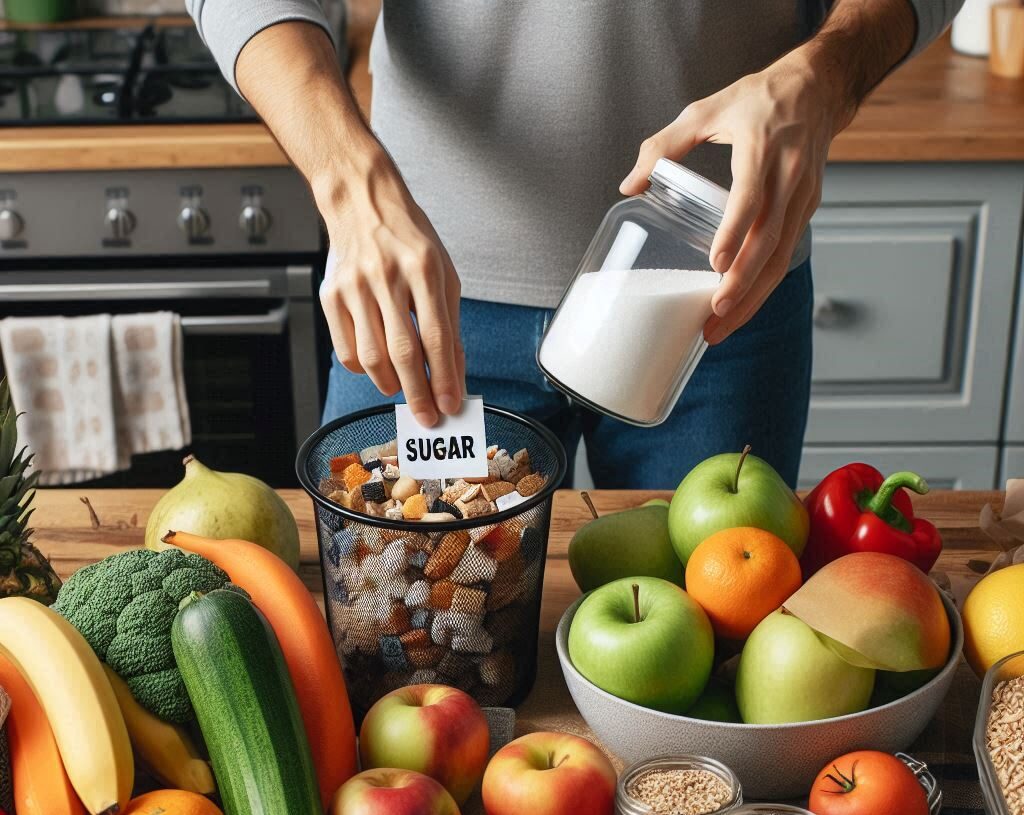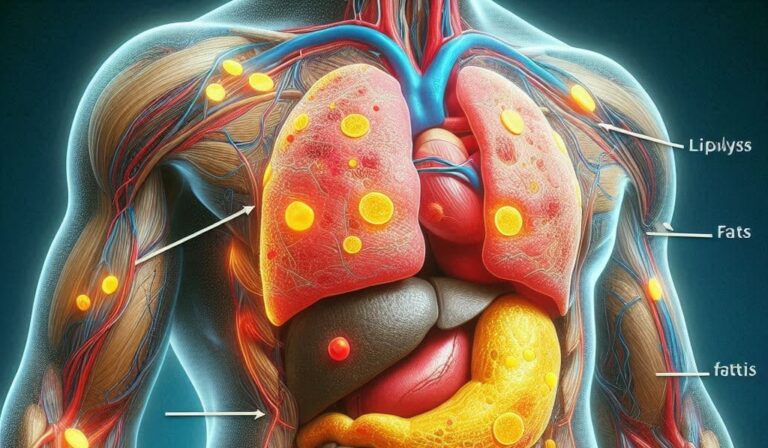How To Eliminate Sugar In Your Diet
How to Eliminate Sugar in Your Diet: Practical and Effective Strategies for Better Health and Well-Being Eliminating sugar from your diet can seem scary, but it is achievable with the right strategies and mindset. Reducing sugar intake can have profound benefits if you want to improve your overall weight and health and feel better daily.
I will tell you a secret: Sugar hides in plain sight, and it’s not just where you’d expect. If you’re determined to cut sugar from your diet, your first step is to become a detective in your kitchen. That means picking up every package and scrutinizing the label. Sugar is a master of disguise, sneaking into your meals under aliases like ‘high-fructose corn syrup,’ ‘sucrose,’ or even ‘evaporated cane juice.’

Uncovering Hidden Sugars in Your Diet
- Read Labels Carefully:
-
- Check Ingredients: Look at the list of ingredients in packaged foods. Sugar can appear under many different names.
- Common Aliases for Sugar: Some of the most common names for added sugars include high-fructose corn syrup, sucrose, glucose, fructose, maltose, dextrose, and evaporated cane juice.
- Recognize Sugar’s Many Forms:
-
- Natural vs. Added Sugars: Understand the difference between natural sugars (found in fruits and dairy) and added sugars. Added sugars are those that manufacturers put into products during processing.
- Hidden Sugars in ‘Healthy’ Foods: Foods labeled ‘low-fat’ or ‘diet’ often have added sugars to improve taste. Be especially cautious with items like yogurt, granola, and salad dressings.
- Understand Nutritional Labels:
-
- Total Sugars vs. Added Sugars: Check the Nutrition Facts label for total and added sugars. The FDA now requires added sugars to be listed separately, making it easier to spot them.
- Serving Sizes: Pay attention to serving sizes. A product might seem low in sugar, but if you consume more than the serving size, you might get more sugar than you realize.
Common Foods with Hidden Sugars
- Condiments and Sauces:
-
- Ketchup and Barbecue Sauce: These often contain high amounts of sugar.
- Salad Dressings: Those labeled as ‘low-fat’ can have added sugars.
- Packaged Foods:
-
- Bread and Baked Goods: Many breads, muffins, and pastries have added sugars.
- Cereals and Granola Bars: Even ‘healthy’ or ‘whole grain’ varieties can be loaded with sugar.
- Dairy Products:
-
- Flavored Yogurts: Often contain more sugar than a serving of ice cream.
- Milk Alternatives: Some almond, soy, and coconut milk have added sugars, especially flavored versions.
- Snacks and Processed Foods:
-
- Crackers and Chips: Some savory snacks have added sugars.
- Canned Soups and Ready Meals: Sugar is often used as a preservative or to enhance flavor.
By becoming vigilant about reading labels and understanding sugar’s many disguises, you can make more informed choices and significantly reduce your sugar intake. Learning these names has a big payoff.
Once you do, you’ll see them everywhere: bread, pasta sauce, salad dressings, and many ‘low-fat’ options. They’re all potential sugar bombs. Don’t worry too much about memorizing an exhaustive list; get to know the most common culprits.
You’ll find out that focusing on whole, unprocessed foods is a game-changer. Your new best friends are fresh fruits, vibrant veggies, lean proteins, and hearty whole grains. These foods are the antithesis of processed goods, rich in nutrients and naturally low in sugar. Whole foods don’t need labels; their ingredients are themselves.
Choose something that resonates with you, whether it’s a fresh apple crunch or the heartiness of quinoa. Integrating more unprocessed foods into your diet doesn’t just lower your sugar intake; it elevates your overall nutritional profile, which is better for your waistline and general health.

Sugar-Free Hydration and Cooking: Sip Smart and Create at Home
Don’t worry too much about missing your favorite sugary drinks once you discover the refreshing alternatives. Sodas, sweetened teas, and fruit juices are notorious for their high sugar content. A simple switch to water, especially when infused with a splash of natural flavors like lemon or lime, can work wonders for your body. Herbal teas offer a comforting substitute without added sugars, keeping you hydrated.
Cooking at home saves you money and has significant health benefits. When you prepare your meals, you ultimately control what goes into them, including the amount of sugar. Fresh, whole ingredients can drastically reduce hidden sugars often found in restaurants and fast food.
Now, let’s talk about seasoning that doesn’t rely on sugar. I’ll show you how using a variety of herbs and spices can inject flavor into your meals without the need for the sweet stuff. Think cinnamon in your oatmeal instead of sugar or a splash of balsamic vinegar on your salad instead of a sweet dressing. These simple swaps enhance the taste and boost the nutritional value of your dishes.
Natural Over Artificial: Sweeteners and Snack Swaps
I will tell you a little secret:
When cutting sugar from your diet, not all sweet things are off-limits. It’s about choosing clever, natural alternatives. Let’s discuss satisfying that sweet tooth without resorting to the sugar bowl.
You can always swap sugary treats for more wholesome snacks. Think nuts and seeds, which are not only free from added sugars but also packed with nutrients that benefit your body. Or grab a piece of fresh fruit.
Here are some specific benefits and ideas for wholesome snacks:
Nuts and Seeds
Benefits:
- Nutrient-Dense: Nuts and seeds contain essential nutrients such as healthy fats, protein, fiber, vitamins, and minerals.
- Heart Health: They contain healthy fats like omega-3 and omega-6 fatty acids, which can support heart health.
- Satiety: The protein and fiber in seeds and nuts help you feel fuller for longer, reducing the likelihood of overeating.
Snack Ideas:
- Almonds: Rich in vitamin E, magnesium, and antioxidants.
- Walnuts: High in omega-3 fatty acids and good for brain health.
- Pumpkin Seeds: Provide magnesium, zinc, and antioxidants.
- Chia Seeds: A great omega-3 fatty acids, fiber, and protein source. It can be added to yogurt or smoothies.
Fresh Fruit
Benefits:
- Natural Sugars: Fruits contain healthier natural sugars than added sugars found in processed snacks.
- Fiber: The fiber in fruit helps regulate blood sugar levels and supports digestive health.
- Vitamins and Antioxidants: Fruits are rich in essential vitamins like vitamin C and antioxidants that protect the body from oxidative stress.
Snack Ideas:
- Apple Slices with Peanut Butter: A combination of fiber, protein, and healthy fats.
- Bananas: High in potassium and suitable for quick energy.
- Berries (Strawberries, Blueberries, Raspberries): Low in calories but high in fiber, vitamins, and antioxidants.
- Orange Segments: Great source of vitamin C.
Combining Nuts, Seeds, and Fruits
Trail Mix: Make your own homemade trail mix with nuts, seeds, and dried fruits (choose unsweetened varieties to avoid added sugars).

Smoothie: Blend a mix of fruits with a handful of nuts or seeds for a nutritious and filling smoothie.
Choosing these wholesome snacks over sugary treats reduces added sugar intake and nourishes your body with essential nutrients that promote long-term health.
If you need a sweet fix, natural sweeteners like stevia or monk fruit are your friends – in moderation. They don’t impact your blood sugar like table sugar does, which can help you keep cravings in check. Plus, they’re a lot sweeter than sugar, so a little goes a long way.
Don’t worry too much about cutting every sweet flavor from your life. The goal is to make better choices, not to deprive yourself. By swapping out candies for healthier options and replacing artificial sweeteners with natural ones, you’re already making strides toward a healthier diet without sacrificing satisfaction.
Remember, it’s not just about cutting out sugar; it’s about creating healthier habits that last. So choose something that resonates with you, whether savoring a square of dark chocolate or blending up a fruit smoothie. These healthier swaps can make the transition away from sugar much more accessible.
A Balanced Path to Sugar Reduction: Steady Steps to Success
Embracing a low-sugar lifestyle isn’t about drastic overhauls; it’s about making consistent, reasonable changes. Gradually reducing the sugar in your diet prevents your taste buds from rebelling and makes the transition much smoother. Amid these changes, remember the power of balanced meals. Including a combination of protein, healthy fats, and fiber in every meal can stabilize your blood sugar levels and help prevent sugar cravings.
Hydration is another weapon in your arsenal when battling excess sugar intake. Sometimes, when you think you’re hungry, you’re just thirsty. Drinking enough water throughout the day can stave off unwanted snacking, helping you avoid reaching for that candy bar.
I’m a firm believer in moderation. Fruit, while a healthier choice, still contains natural sugars, so you must be mindful of portions. It’s okay to enjoy a ripe mango or a handful of grapes – remember to enjoy it in moderation and as part of a balanced diet.
Tips for Reducing Sugar Intake
Cook from Scratch:
- Control Ingredients: Preparing meals at home lets you control what goes into your food.
- Whole Foods: Use whole, unprocessed ingredients whenever possible.
Choose Whole Fruits Over Juices:
- Whole Fruits: They contain fiber, which helps moderate the absorption of natural sugars.
- Limit Fruit Juice: Even 100% fruit juice can contain a lot of sugar and lacks the fiber in whole fruits.
Healthy Alternatives:
- Natural Sweeteners: If you need a touch of sweetness, use alternatives like monk fruit, stevia, or a small amount of maple syrup or honey.
- Spices: Enhance flavors with cinnamon, nutmeg, or vanilla extract instead of sugar.
Summary
As you embark on this journey, remember that each small victory adds up. Your first attempt doesn’t need to be your last, and perfection isn’t the goal; better health is. Choose what resonates with you from these strategies, and don’t worry too much about slip-ups– you can constantly adjust your approach. I hope you find these steps helpful as you reduce sugar and enjoy a healthier eating pattern.
If you found this interesting, you should read my other articles on how to stay motivated on a weight loss journey.
Engage with Me!
Ask Questions: If you have any questions about eliminating sugar in your diet, please comment below. Thank you!




This article on eliminating sugar from your diet is incredibly practical and informative! I appreciate the detailed tips on identifying hidden sugars and making healthier swaps. I have a few questions:
Do you have any favorite recipes for homemade snacks that are both low in sugar and delicious?
How long does it typically take for taste buds to adjust to a lower sugar diet?
Can you suggest any specific brands of natural sweeteners that you find particularly effective?
What are some strategies for handling sugar cravings during the initial transition period?
Thanks for the great advice!
Hello, Ashley,
Thank you for your response! I’m glad you found the article practical and informative. Here are some answers to your questions:
My Favorite Recipes for Homemade Snacks:
Energy Balls: Made with oats, nut butter, chia seeds, and some honey or dates for sweetness.
Greek Yogurt with Berries: Topped with a sprinkle of nuts or seeds for added crunch.
Veggie Sticks with Hummus: A tremendous savory snack that’s low in sugar.
Apple Slices with Almond Butter: A simple and satisfying option.
Adjusting Taste Buds: It typically takes about 2-3 weeks for your taste buds to adjust to a lower-sugar diet. During this time, you may appreciate the natural sweetness of fruits and vegetables more.
Natural Sweeteners: Some influential brands of natural sweeteners include Stevia (like Truvia or SweetLeaf), Monk Fruit (like Lakanto), and Erythritol (like Swerve). These can be good alternatives to refined sugar.
Handling Sugar Cravings:
Stay Hydrated: Sometimes, cravings can be a sign of dehydration.
Eat Regularly: Eat balanced meals with protein, healthy fats, and fiber to keep your blood sugar stable.
Find Healthy Alternatives: Satisfy your sweet tooth with fruits or a small amount of dark chocolate.
Keep Busy: Engage in activities you enjoy to distract yourself from cravings.
I hope these tips help you to eliminate sugar from your diet. Feel free to reach out if you have more questions or need further support!
Best regards,
Michael
Wow this is something I want to do! Eliminating sugar from my life has been one of my priorities in my life, but I’m failing because I’m quite addicted to sugar. And I’ve also my nephew who always makes me buy some many things like pizzas with lots of ketchup! Anyway…I decided to eradicate all sugar by July 1. And I’m dedicated to get the most of my O blood type diet!
Hi Angelce,
That’s a fantastic goal! Eliminating sugar from your diet can be challenging, especially with temptations, but your determination is inspiring. Setting a date like July 1 is a great way to commit to your goal.
Balancing dietary changes with family can be challenging. Perhaps involving your nephew in healthier eating choices could be a fun way to stay on track together.
Best of luck with your goal! Feel free to reach out if you need any tips or support along the way. You’ve got this!
All the best,
Michael